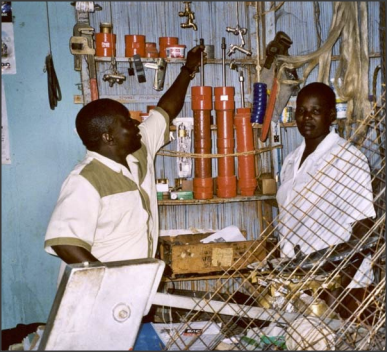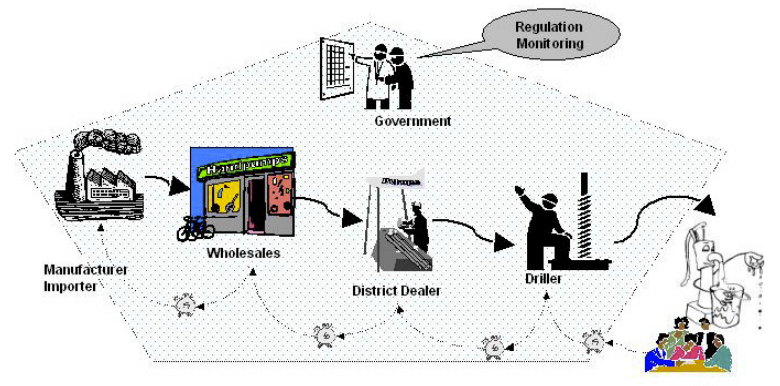Difference between revisions of "Supply Chain"
(Published from sandbox) |
(No difference)
|
Revision as of 00:29, 16 November 2013

In rural water supply and sanitation, goods and services (equipment, training, repair services, financial and technical services, and facility management) have to be supplied through a supply chain from manufacturers, importers, and service providers through a network of distributors to the users.
The need to subsidise the investments for water systems makes the setting up of supply chains complicated. Project centred procurement is often at the core of broken down supply chains. The projects purchase on behalf of users. International importers supply the equipment, and the economically not lucrative sales of spares should be taken up by the local private sector. Buying directly abroad short circuits the essential lower links in the supply chain thus impedes the capacity of local spare parts dealers to support water systems.
Despite best intentions, post-project problems of O&M management coupled with the common inability to reach outlying poor rural areas, put supply chains management issues at the core of sustaining investments. Delivery mechanisms for spare parts and repair services have consistently failed because of limited resources, and a lack of incentives, resulting in a high percentage of nonfunctioning handpumps and water systems only a few years after their installation. This is a problem particularly acute in Sub-Saharan Africa.
The underlying objective of a functioning and sustainable supply chain is to deliver a successful product to the customer, and all involved stakeholders make an acceptable profit. There has to be a demand for a product that is:
- available;
- affordable
- of adequate quality; and
- delivered in an appropriate time.
How does a supply chain work?
Supply chains transform raw materials to products, which are sold to customers. Payment for this process flows in the opposite direction in the chain.

Business approach to successful supply chains
Five key factors are essential for a successful “business approach” in a supply chain:
Adequate Demand - A continued demand for the goods and services, which are provided through a supply chain, is the fundamental factor for the sustained operation. Specific factors are important to generate such product demand. They include, primarily, the felt need for safe water supply and sanitation services by the users. A supply chain only exists in response to customer demand. Without adequate demand, a supply chain will not develop and function sustainably. In complex systems, the operators (who might be running the systems on commercial basis) express the demand more explicitly.
In community-based maintenance, the demand is often not so clearly articulated. Development of self-supporting, sustainable markets with a continued demand for water supply and sanitation products (e.g. new equipment, spare parts and repair services) is not necessarily created by projects despite the fact that they might be the biggest buyers. Their interventions often have a distorting effect on the market. Project procurement does not reflect demand, and is detrimental to the creation of viable private sector markets. Cost for investment and maintenance, appropriate products, and simplicity of the technology are other important factors.
Effective Stakeholder Incentives - For the private sector to stay involved in business as a link in a supply chain, the suppliers must have sufficient motivation and confidence that the products offered will yield enough profit to make the initial investment and the continued effort worthwhile.
Effective Information Flow - To create and maintain the supply chain there must be adequate information flow between stakeholders, and improved communications. Customers need to know where they can get the products. Suppliers need to be aware of long-term policies and strategies in order to invest into the access to the market.
Effective Supply Chain Management - Useful supply chain management means to intervene as little as possible but to build effective relations between stakeholders, to identify and develop potential partners in the chain, to make partners aware of the 'bigger picture' and to create a collaborative environment for planning.
Enabling Environment - Policies of Governments, Donors, and NGOs should create an enabling environment, which does not inhibit the markets. Enabling environment also means stability of the market. Entering a market requires an investment, which should have a reasonable rate of return. If the prospects of staying in the market are short, the investment costs need to be recovered in this short period. All of these additional factors are mutually important for a successful supply chain and there are many linkages between them.
Field experiences
| Akvo RSR Project: Water training centre in Malawi
This project focuses on training local businesses that will produce and sell new low cost water solutions that are affordable for (groups of) households. Demand and investments will be stimulated through social marketing and with the help of the Watsan Centre of Excellence. The goal is to establish a sustainable and competitive supply sector that offers a wide range of low cost water options (pumps, filters, etc) that can deliver water for middle and low income families. |
Manuals, videos and links
- Tanzania Supply Chain Study Report. BAUMANN E and LYIMO B, Skat, 2000.
- Sustainable Supply Chains for Rural Water Services: Linking local procurement of handpumps and spare parts supply. HARVEY, P., RWSN, UNICEF SDC, 2011.
- Setting up viable supply chains for Hand Pumps in Vietnam. Summary of an appraisal and impact assessment of the Government of Vietnam-IDE Hand Pump Promotion Program, funded by ICCO. IKIN, D. and E. BAUMANN, RWSN, Skat SDC, 2001.
- Rural sanitation supply chain and finance. Information and outputs related to strengthening sanitation supply chain development. One of the implementing components of the Sustainable Sanitation and Hygiene for All (SSH4A) programme. IRC.
in Rural East Java |
In Indonesia, where rural sanitation coverage remained low, at under 40% for decades, sanitation has suddenly become a profitable, fast growing business. This video features small-scale sanitation entrepreneurs serving households in Indonesia’s East Java province, one of the most densely populated places on earth (38 million people). The video highlights the importance of sanitation champions and creative approaches to generate demand for sanitation, in addition to efforts to improve the sanitation supply chain. |
Acknowledgements
- Supply Chain Issues for WES Facilities. Karl Erpf/Erich Baumann, August 2004.

